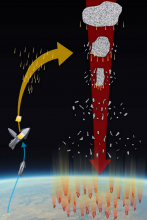Listen to today's episode of StarDate on the web the same day it airs in high-quality streaming audio without any extra ads or announcements. Choose a $8 one-month pass, or listen every day for a year for just $30.
You are here
Mars and Venus
Mars and Venus are staging an amazing show in the western evening sky. Venus is big and bright — the “evening star.” Mars is just one-half of one percent as bright. But its closeness to Venus will help it stand out. Tonight, it’s only about a degree and a half away — the width of a finger held at arm’s length.
One reason Venus looks so much brighter is that it’s covered by clouds. They hide the surface, but they also help protect it.
The most common features on Venus are volcanoes and related structures. Impact craters — the scars of collisions with big space rocks — are much less common. Scientists have cataloged fewer than a thousand of them. The largest is only about 175 miles in diameter.
That’s largely because of Venus’s atmosphere. It’s extremely dense, and its clouds are made of sulfuric acid. So when a space rock slams into Venus, it’s likely to burn up or split apart before it hits the ground.
Mars, on the other hand, is a crater-lover’s paradise. Scientists have cataloged hundreds of thousands of them that are at least two-thirds of a mile in diameter. The largest is a shallow basin a thousand miles across.
Mars’s atmosphere is less than one percent as thick as Earth’s. So when a big space rock takes aim, there’s not much to keep it from hitting. And there’s not much to erase impact craters, either. So they just keep adding up — more big holes on the Red Planet.
More about Mars and Venus tomorrow.
Script by Damond Benningfield






